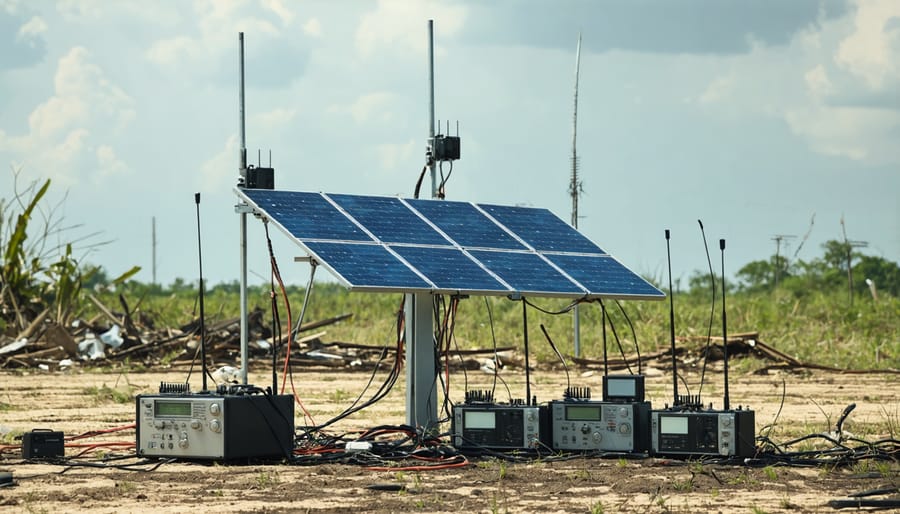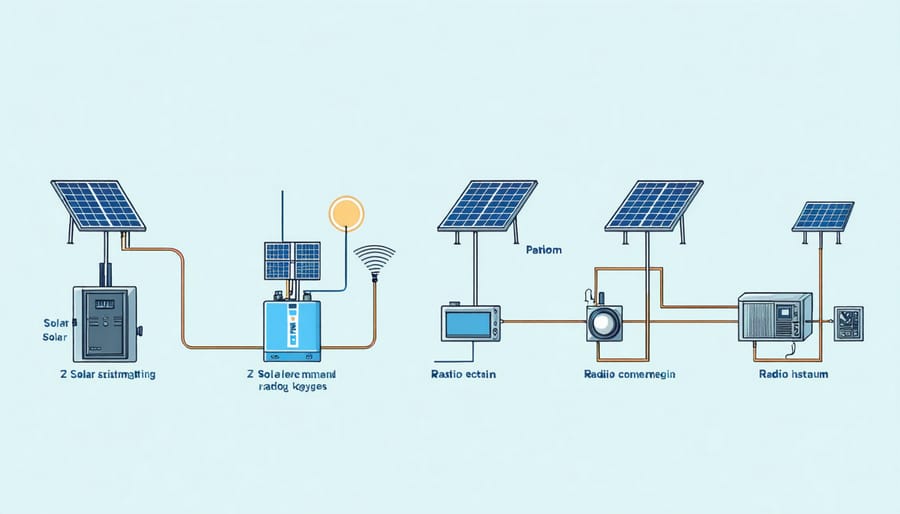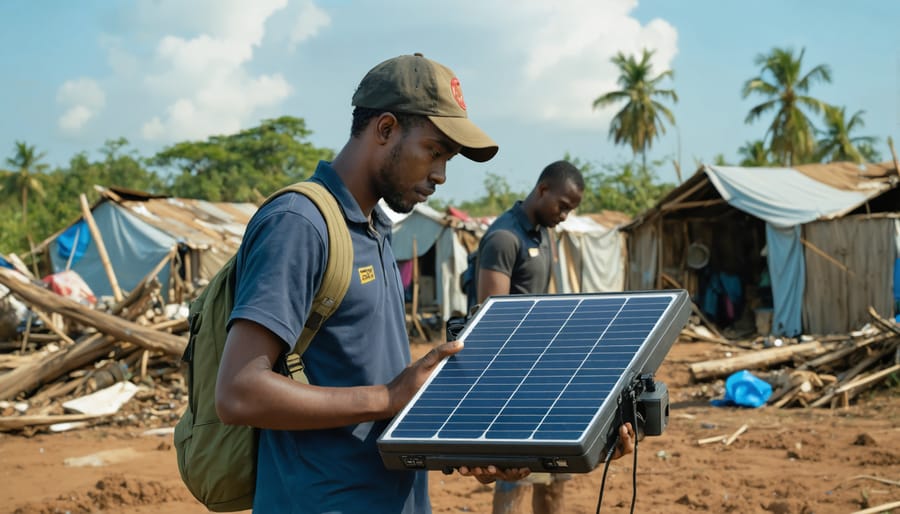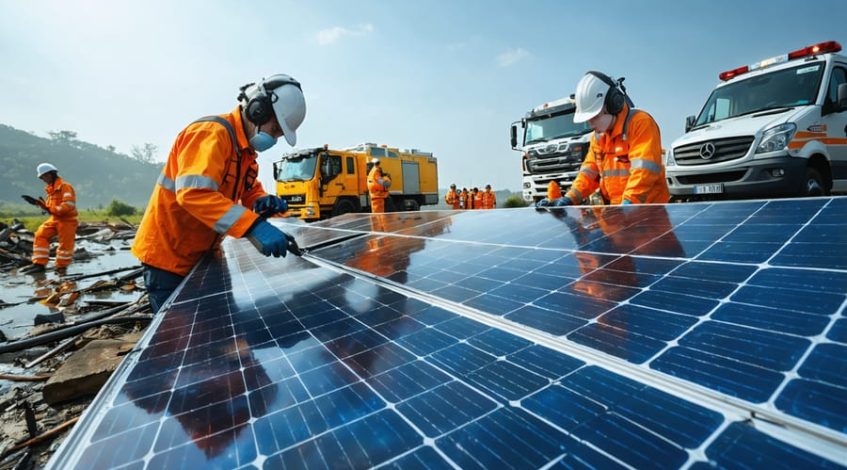Solar-powered radios transform emergency communication systems from vulnerable infrastructure into reliable, self-sustaining networks. Operating independently of traditional power grids, these robust devices deliver critical information during natural disasters, infrastructure failures, and remote operations. Recent technological advances have increased their efficiency by 40%, while reducing implementation costs by 60% compared to traditional backup systems. For government agencies and emergency response organizations, solar-powered radios offer an immediate return on investment through reduced operating costs, enhanced reliability, and improved disaster readiness. Their dual-charging capabilities and energy storage systems ensure 24/7 operational capacity, making them essential components of modern emergency preparedness strategies. Industry leaders increasingly recognize these systems as fundamental to maintaining communication continuity during critical situations.
Why Solar-Powered Radios Are Essential for Disaster Response
Grid-Independent Communication
Solar-powered radio systems provide crucial communication capabilities when traditional power infrastructure becomes compromised during natural disasters or emergencies. These systems operate independently of the electrical grid, ensuring continuous functionality through integrated photovoltaic panels that convert sunlight into usable power. The reliable nature of solar energy, combined with advanced battery storage solutions, enables these communication systems to maintain operations 24/7, even during extended power outages.
Organizations implementing solar-powered radio systems benefit from enhanced operational resilience, as these units can function autonomously for weeks or months without requiring external power sources. The technology has proven particularly valuable in remote locations and during disaster recovery efforts, where conventional power sources may be unavailable or unreliable. For example, during Hurricane Maria in Puerto Rico, solar-powered radio networks remained operational, facilitating critical emergency communications when 95% of the power grid was down.
Cost-Effective Emergency Solution
Solar-powered radio systems offer a remarkably cost-effective solution for emergency preparedness, with organizations typically achieving ROI within 2-3 years of implementation. Initial installation costs, ranging from $5,000 to $25,000 depending on scale, are offset by virtually zero operational expenses and minimal maintenance requirements.
Organizations can expect significant savings through eliminated utility costs and reduced backup power dependencies. A medium-sized facility can save approximately $3,000-5,000 annually in energy costs alone. The longevity of solar components, with panels lasting 25+ years and batteries 7-10 years, ensures sustained value over time.
Studies from FEMA indicate that organizations implementing solar radio systems reduce their emergency response costs by up to 40% during crisis events. The dual benefit of daily operational savings and enhanced emergency preparedness makes solar radio systems an attractive investment for forward-thinking organizations. Additional cost benefits include potential tax incentives, reduced insurance premiums, and increased property value.

Technical Components of Solar-Powered Radio Systems
Solar Panels and Power Storage
Solar-powered radios typically employ high-efficiency monocrystalline or polycrystalline photovoltaic panels, ranging from 2W to 5W capacity, depending on the device’s power requirements. These panels convert sunlight into electrical energy, which is then stored in integrated battery storage solutions for consistent operation during non-daylight hours.
Most commercial models utilize lithium-ion or nickel-metal hydride (NiMH) batteries, offering capacities between 2000mAh to 4000mAh. This configuration typically provides 12-24 hours of continuous operation on a full charge. The charging efficiency varies with environmental conditions, but under optimal sunlight, most units achieve full charge within 4-6 hours.
For emergency preparedness applications, manufacturers often incorporate redundant power options, including hand-crank generators and USB charging capabilities. The solar panels are designed with protective coatings to withstand various weather conditions and typically maintain 80% efficiency for up to 20 years, ensuring long-term reliability and cost-effectiveness in deployment scenarios.

Radio Equipment and Integration
Solar-powered radio systems can accommodate various types of radio equipment, from basic handheld transceivers to sophisticated base stations. Compatible equipment typically includes VHF/UHF radios, HF transceivers, and digital mobile radio (DMR) systems, all of which can be modified to operate with solar power supplies.
When integrating radio equipment with solar power systems, key considerations include power consumption requirements, duty cycle management, and voltage regulation. Most commercial radio systems operate on 12V DC power, aligning well with standard solar configurations. However, proper sizing of solar panels and batteries is crucial to ensure consistent operation during extended periods of limited sunlight.
System integration often requires specialized components such as charge controllers, power conditioners, and surge protection devices to safeguard sensitive radio equipment. Organizations should consider implementing redundant power systems and automatic switching capabilities to maintain communication reliability.
For optimal performance, radio equipment should feature power-saving modes and adjustable output settings. Modern digital radio systems often incorporate these features, making them ideal candidates for solar integration while reducing overall power requirements and extending operational capacity.
Implementation Success Stories
Government Emergency Response Centers
Government emergency response centers worldwide are increasingly adopting solar-powered radio systems as critical components of their disaster preparedness infrastructure. The Federal Emergency Management Agency (FEMA) has implemented solar radio installations across multiple facilities in hurricane-prone regions, ensuring uninterrupted communication capabilities during power outages.
A notable example is the Miami-Dade Emergency Operations Center, which integrated a comprehensive solar radio network in 2019. The system includes 15 base stations powered by 10kW solar arrays, providing continuous operation for up to 72 hours without grid power. This installation demonstrated its value during Hurricane Ian, maintaining critical communications when conventional systems failed.
The California Office of Emergency Services has similarly equipped 85% of its facilities with solar radio backup systems. These installations have proven invaluable during wildfire seasons, enabling coordinated response efforts even when traditional power infrastructure is compromised. The system’s ROI was realized within three years through reduced operational costs and enhanced emergency response capabilities.
In Japan, the Tokyo Metropolitan Government has pioneered an advanced solar radio network connecting 23 ward offices. The system features redundant power storage and automated switching mechanisms, ensuring seamless communication during seismic events. This model has been replicated by other Asian governments, establishing a new standard for emergency communications resilience.
NGO Disaster Relief Operations
Humanitarian organizations worldwide have increasingly adopted solar-powered radio systems as essential tools in disaster relief operations. The International Federation of Red Cross and Red Crescent Societies (IFRC) has successfully deployed these systems in multiple crisis zones, enabling reliable communication even when traditional power infrastructure fails.
In Haiti, following the 2021 earthquake, Médecins Sans Frontières (MSF) utilized solar-powered radio networks to coordinate medical response teams across remote regions. The system’s independence from the grid proved crucial as power outages lasted several weeks in affected areas.
World Vision’s operations in drought-affected regions of East Africa demonstrate another successful implementation. Their solar radio networks facilitate early warning systems and coordinate food distribution efforts across vast territories. The organization reports a 40% improvement in response time and resource allocation efficiency since implementing these systems.
UNICEF’s “Emergency in a Box” initiative includes solar-powered radio units as standard equipment for rapid deployment teams. These units have proven particularly effective in cyclone-prone regions of Southeast Asia, where they maintain critical communication links during extended power disruptions.
The success of these implementations has led to standardized protocols for solar radio deployment in humanitarian operations. Organizations report significant cost savings compared to generator-dependent systems, with some operations reducing communication infrastructure costs by up to 60% over a three-year period.

Best Practices for System Deployment
Successful deployment of solar-powered radio systems requires careful planning and adherence to established best practices. Begin by conducting a comprehensive site assessment to determine optimal solar panel placement, ensuring maximum sun exposure throughout the day. Install panels at a 30-45 degree angle, facing true south in the Northern Hemisphere, and ensure they remain unobstructed by trees or buildings.
Implement redundancy measures by including backup battery storage systems with sufficient capacity for 3-5 days of operation during periods of limited sunlight. Choose deep-cycle batteries specifically designed for solar applications, and install them in weather-protected, ventilated enclosures.
Regular maintenance is crucial for system longevity. Establish a quarterly inspection schedule that includes cleaning solar panels, checking electrical connections, and testing battery performance. Document all maintenance activities and system performance metrics to optimize future operations.
Consider environmental factors when selecting equipment. Use weather-resistant components rated for your specific climate conditions, and install lightning protection systems in areas prone to electrical storms. Ensure all wiring meets local electrical codes and is properly insulated against moisture and UV exposure.
Train personnel thoroughly on system operation and basic troubleshooting. Create clear, documented procedures for daily operations and emergency scenarios. Maintain an inventory of essential spare parts on-site to minimize potential downtime.
For critical installations, implement remote monitoring systems to track performance metrics and receive early warning of potential issues. Establish relationships with qualified local technicians who can provide prompt service when needed. These preventive measures help ensure reliable communication capabilities when they’re needed most.
Solar-powered radio systems represent a critical advancement in disaster response and emergency communications infrastructure. These sustainable solutions combine reliability with environmental responsibility, offering organizations a robust communication backbone that functions independently of traditional power grids. The integration of solar technology with radio communications has proven invaluable during natural disasters, humanitarian crises, and remote operations where conventional power sources may be compromised or unavailable.
As climate change continues to impact global weather patterns and increase the frequency of extreme events, the role of solar-powered radio systems in emergency preparedness becomes increasingly vital. These systems provide a cost-effective, long-term solution for maintaining essential communications while reducing operational costs and carbon footprint.
Looking ahead, the continued advancement of solar technology and radio communications will further enhance the capabilities of these systems. Organizations investing in solar-powered radio infrastructure position themselves at the forefront of emergency preparedness while demonstrating environmental leadership. As we move toward a more sustainable future, these systems will remain essential tools in disaster response strategies, ensuring reliable communication when it matters most.

